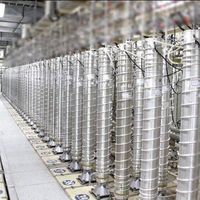Iran’s Nuclear Power Output Declines Amid Controversy Over Russia’s Role
Iran’s nuclear electricity generation declined 20% year-on-year to below 4.4 terawatt-hour (TWh) during last Iranian fiscal year, ended March 21.
According to official statistics reported by Fars News affiliated with the Revolutionary Guard, the country’s nuclear electricity generation has been declining since 2017, when it reached the peak level of 7.5 TWh electricity generation.
Iranian official sources do not offer any explanation for the decline in production. Iran owes Russia hundreds of millions of dollars for the Bushehr reactor, and it is not clear if this has been impacting the reactor’s operations and maintenance.
After two decades of delays, Russian Rosatom finally inaugurated Iran’s only nuclear power plant, Bushehr, ten years ago.
Neither Iran nor Rosatom have reported the financial expenditure of this project, but Iranian former vice president Es’haq Jahangiri said in 2020 that around $8.5 billion was spent on this project.
Developing the Bushehr nuclear power plant (NPP) with 1000 MW capacity at this cost made it one of the most expensive nuclear power plants in the world. For instance, South Korean KEPCO has been developing the United Arab Emirates’ Barakah NPP with 6500 MW capacity since 2012 and its two reactors with 2800 MW capacity are already in operation, with two more reactors being built. The cost of building the reactors is estimated at just above $20 billion, much cheaper than Bushehr NPP.
On the other hand, official figures show that the cumulative electricity generation from Bushehr nuclear power plant during last ten years is about 47.7 TWh, worth about $5 billion. That is far behind its $8.5 billion capital expenditures. In fact, around 20 percent of power generated was used in the nuclear plant itself and 80 percent reached the power grid.
Bushehr nuclear power plant produced only 1.25% of the country’s electricity during last fiscal year, ending March 20, 2022.
Russia and Iran have started negotiations on building two more reactors with 2,000 MW capacity for a total of $10 billion. This price tag is also much too high, compared to KEPCO’s reactors for UAE with a cost of $20 billion for 6,500 MW capacity.
The issue of Russia’s involvement in Iran’s civilian nuclear reactor was long kept separate from its controversial nuclear program involving uranium enrichment that led to major international sanctions a decade ago. But this month as Iran and the West reached the final stages of a new round of talks in Vienna to revive the 2015 nuclear agreement, JCPOA, the Russian role in building reactors for Iran became entangled with the non-proliferation talks.
As the West imposed sanctions on Moscow for its invasion of Ukraine, Russia demanded an exception from the United States on March 5 to continue its activities in Iran unhindered. After a few days of behind the scenes talks, the Biden Administration apparently agreed amid an ever-tightening sanctions regime against Russia. This generated strong domestic opposition, mostly by Republicans and some Democrats, who were already skeptical about the nuclear talks with Iran.
They argue that restoring the JCPOA, abandoned by former president Donald Trump in 2018, is not worth giving an exception from Ukraine sanctions to Russia.








